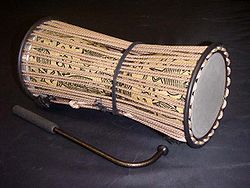Talking drum
 |
|
| Percussion instrument | |
|---|---|
| Other names | Dondo, Odondo, Tamanin, Lunna, Donno, Kalangu, Dan karbi, Igba, Doodo, Tama, Tamma, Dundun, Gangan |
| Classification | Percussion |
| Hornbostel–Sachs classification | 211.242.11 (Individual double-skin hourglass-shaped drums, one skin used for playing) |
| Developed | Antiquity |
The Talking drum is an hourglass-shaped drum from West Africa, whose pitch can be regulated to mimic the tone and prosody of human speech. It has two drumheads connected by leather tension cords, which allow the player to modulate the pitch of the drum by squeezing the cords between their arm and body. A skilled player is able to play whole phrases. Most talking drums sound like a human humming depending on the way you play. Similar hourglass-shaped drums are found in Asia, but they are not used to mimic speech, although the idakka is used to mimic vocal music.
Hourglass-shaped talking drums are some of the oldest instruments used by West African griots and their history can be traced back to the Yoruba people, the Ghana Empire and the Hausa people. The Yoruba people of south western Nigeria and Benin and the Dagomba of northern Ghana) have developed a highly sophisticated genre of griot music centering on the talking drum . Many variants of the talking drums evolved, with most of them having the same construction mentioned above. Soon, many non-hourglass shapes showed up and were given special names, such as the Dunan, Sangban, Kenkeni, Fontomfrom and Ngoma drums. Interestingly, this construction is limited to within the contemporary borders of West Africa, with exceptions to this rule being northern Cameroon and western Chad; areas which have shared populations belonging to groups predominant in their bordering West African countries, such as the Kanuri, Djerma, Fulani and Hausa.
...
Wikipedia
